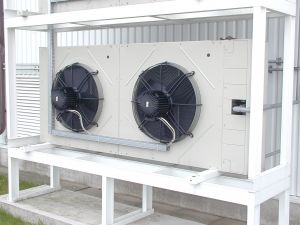Ductless Air Conditioning Explained
If you need a portable indoor cooling solution but don't want to visibly vent to the outside, a ductless air conditioning unit is your answer.
I explain how it works and how you can benefit in many ways from choosing this kind of air cooling device.
Before I go into detail about how a ventless air cooling unit works, let's first recap on how a conventional portable air conditioner chills the air in your room.
The process is not unlike the way in which your domestic refrigerator keeps the food inside it cold.
Conventional Air Chilling Process
 Warm air is sucked into the indoor mounted compressor unit using a fan.
Warm air is sucked into the indoor mounted compressor unit using a fan.
It is then passed across the cooling coils stage which uses refrigerant gasses to chill the air.
This creates a heat exchange whereby the air that is expelled into the room is chilled and the heated exhaust air that is a by-product of the exchange is vented out of the rear of the unit. This is generally ducted though an external wall of your house to an outside mounted condenser unit that vents the hot air to be carried away in the breeze, or rise naturally, since hot air rises.
The major downside to this type of unit is that there must be some way of venting included in the process to carry the hot exhaust air out of the house. If it did not and, as in the case of portable air conditioners, the vent was just left dangling out the back of the unit in the room, there would actually be a net increase in the room temperature because there is more hot air than cold air produced by the refrigeration process!
The best way to have all the benefits of AC without the ducting, hassle or mess is to get clever with the way it's configured. Now's your chance to read up on some wall mount ductless mini split air conditioner reviews and find out what you need to know, below:
Windowless, Ductless Wall Mount Mini-Spilt Air Conditioners
This is a very popular configuration of AC and a great alternative to a central HVAC system that provides all the benefits without the disadvantages or expense.
This type of cooler is often referred to as the "ductless" AC since it is installed in such a way that the through-wall duct is concealed behind the indoor unit.
The hidden vent or duct often connects directly to the external condenser/extractor unit on the other side of the external wall it is fitted to, completely concealing the pipe connecting the two from sight both indoors and outdoors. To the right is an example of a popular mini-split system you can buy online at Amazon:
This ultra quiet, powerful and efficient system provides tons of cold air when you need it in summer and heat in winter too! This full set includes an easy installation kit, with a 16 foot length line set as well as a variety of useful accessories.
But if you don't want the expense of AC and are looking for a small, free standing cooler that will provide you with plenty of cold air but no hot air, there is another option: The evaporative (swamp) cooler!
Why Don't Evaporative Coolers Produce Hot Air Too?
The reasoning mind would assume that all air cooling units would work in the same way to create the chilled air necessary to cool the room temperature. This is not the case.
Evaporation-based air cooling devices do not employ a heat exchange system to create cold air. Instead they use nature's own natural "cooling by evaporation" process to achieve the same result, with the major difference that there is only cold air produced by this process.
Another major benefit is that far less power is needed to run this type of appliance, because there is less mechanical processing to be done and there are no refrigerant gasses used. Because there is no refrigeration engine, these units and not only much cheaper to run, they are a lot cheaper to manufacture and that saving is passed on to the customer in lower purchase prices.
So if these units are better, cheaper and totally portable, why do we need any other kind of air cooling device?
There is a Downside
There is a major downside to these evaporative units. That is they become less effective in high humidity climates.
It works in the same way that in very high humidity when your body sweats to keep you cool you don't feel as cool as you would if you were sweating in a hot dry atmosphere.
When the air in a room is already saturated with moisture, pumping more damp air into it will not produce the same chilling effect that pumping the same damp air into dry air would.
In dry climates, portable evaporative coolers are the perfect answer to staying cool in hot weather and can reduce the room temperature by over 30 degrees very quickly. But in humid climates, the effectiveness is greatly reduced and it may become necessary to use a conventional refrigerant powered air conditioner to achieve the same reduction in room temperature.
You Must Choose Depending on Your Climate
Ultimately, the final choice of air cooler will be determined by your climate.
If it is humid and hot, you may not get the best service from a portable ductless air conditioning unit. You would most likely be better served by a conventional alternative.
However, if you live in a hot dry climate then you will gain many benefits from choosing a ductless or vent-free portable air conditioner to keep you cool in hot weather. Check out my page on this kind of cooler by clicking the blue text link in the previous sentence.
[BACK TO TOP]